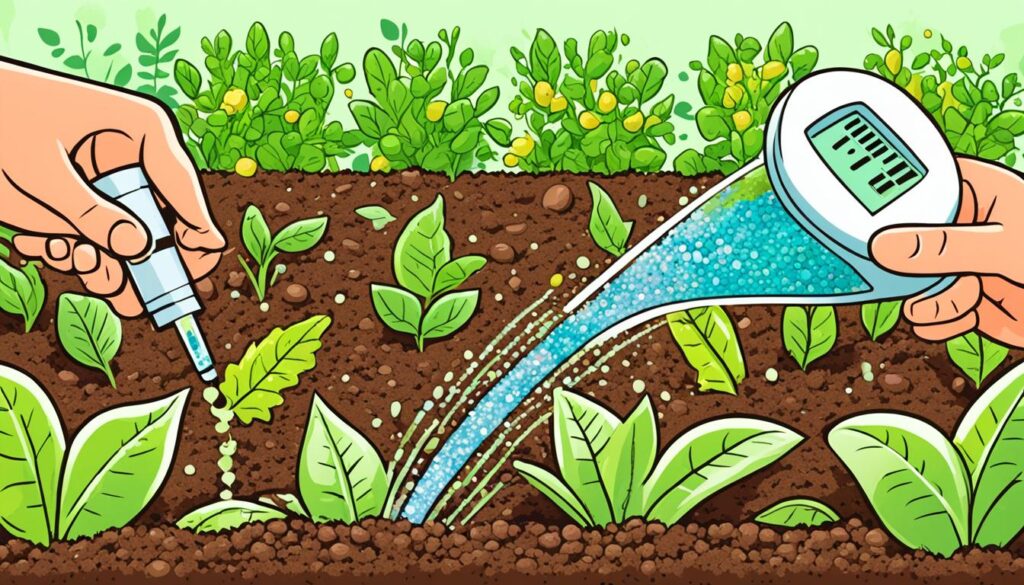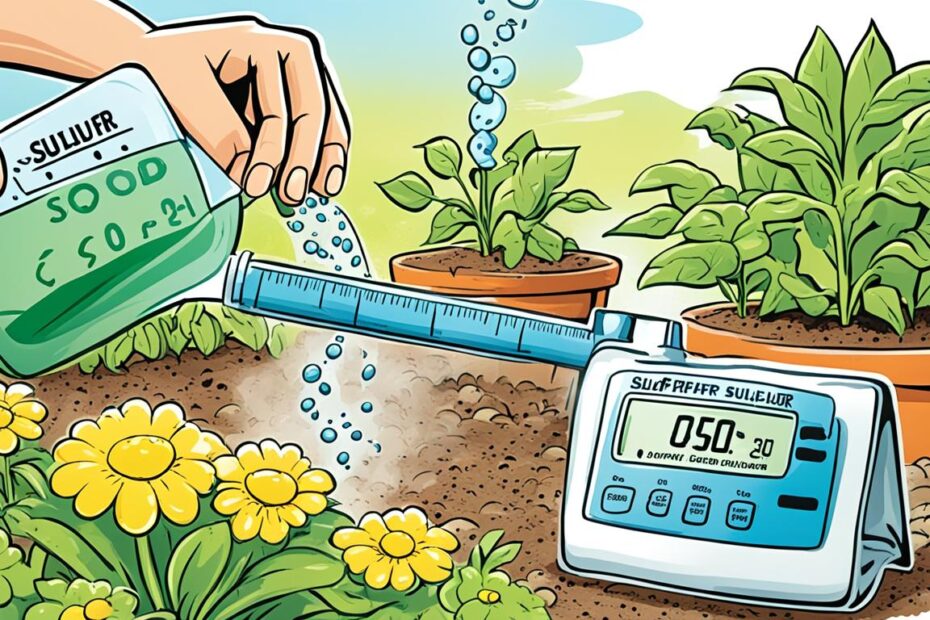Do you want to unleash the full potential of your garden? Are you wondering how to create the perfect environment for your acid-loving plants to thrive? One key factor to consider is the acidity of your soil.
Soil acidity plays a crucial role in nutrient absorption and plant growth. Certain plants, like azaleas, rhododendrons, and blueberries, require a more acidic soil to reach their maximum potential. But how can you increase soil acidity and provide the optimal conditions for your acid-loving plants?
In this article, we will explore the secrets to boosting your garden by increasing soil acidity. From understanding the basics of pH to discovering the best soil amendments and natural methods, you’ll have all the knowledge you need to create the perfect environment for your acid-loving plants to flourish.
Key Takeaways:
- Soil acidity is essential for the health and growth of acid-loving plants.
- Plants like azaleas, rhododendrons, and blueberries thrive in more acidic soil.
- Soil amendments like sulfur, iron sulfate, and sphagnum peat moss can help adjust soil pH levels.
- Conducting a soil test is crucial to determine the types and amounts of amendments required.
- Using natural methods like coffee grounds, pine needles, and oak leaves can also increase soil acidity.
Understanding Soil Acidity: The Basics of pH
Soil acidity plays a critical role in the health and growth of plants. To understand soil acidity, we need to delve into the basics of pH.
Every soil has a unique mineral composition, which in turn affects its acidity or alkalinity. The pH scale, ranging from 0 to 14, helps us measure this acidity level. A pH of 7 is considered neutral, while values below 7 indicate acidity, and those above 7 indicate alkalinity.
Why is pH important for plants?
The pH level of the soil impacts the availability of essential nutrients to plants. Most plants thrive in slightly acidic soil with a pH around 6.5. This optimal pH ensures optimal nutrient absorption and root development.
Iron absorption and soil pH
Soil pH also affects the absorption of specific nutrients, such as iron. In alkaline soil, iron becomes less available to plants, leading to a condition known as iron chlorosis. Plants that require more acidic soil, like azaleas and blueberries, may exhibit signs of iron chlorosis if the soil pH is not within their preferred range.
Testing soil pH
To determine the pH level of soil, conducting a soil test is crucial. Soil testing kits and laboratories can provide accurate pH readings. By understanding the pH level of your soil, you can take appropriate measures to adjust it if necessary.
Image:
Acid-Loving Plants: Which Plants Prefer Acidity
Certain plants thrive in acidic soil. These acid-loving plants have specific pH requirements that contribute to their optimal growth and development. By identifying these plants, you can determine the need for soil amendments and create an environment where they can flourish.
Examples of Acid-Loving Plants
There are several varieties of acid-loving plants that prefer acidic soil. Some commonly known acid-loving shrubs include azaleas, fothergilla, gardenia, holly, and rhododendron. These beautiful shrubs add vibrant colors and delightful fragrances to any garden.
Trees such as oak also thrive in acidic soil. Their majestic presence and shade-providing capabilities make them valuable additions to landscapes. Additionally, certain flowers like hydrangeas display their best colors in acidic soil, showcasing breathtaking blooms.
Acidic soil is essential for the successful cultivation of certain vegetables and fruits. Potatoes, a versatile and nutritious staple in many diets, require acidic soil for optimal growth. Acid-loving fruits like blueberries, cranberries, and currants also flourish in acidic soil, producing plump and flavorful harvests.
It’s important to note that acid-loving plants may exhibit signs of iron chlorosis if grown in soil with a higher pH. This condition manifests as yellowing leaves and reduced growth due to iron deficiency. Providing these plants with the appropriate pH levels ensures their well-being and vitality.
“Acid-loving plants thrive when their soil’s pH level aligns with their specific requirements. Understanding which plants prefer acidity is key to creating an environment conducive to their growth and beauty.”
Acid-Loving Plants and Their Soil Preferences
| Plant | Preferred pH Range |
|---|---|
| Azaleas | 4.5-6 |
| Rhododendron | 5.0-6.0 |
| Blueberries | 4.5-5.5 |
| Gardenia | 5.0-6.0 |
| Potatoes | 4.8-6.0 |

Table: Acid-Loving Plants and Their Soil Preferences
Creating the right soil environment for acid-loving plants is essential for their thriving growth. By understanding the preferences of these plants, you can determine the need for soil amendments and provide them with the optimal conditions to flourish. Remember to prioritize the pH needs of acid-loving plants to achieve a vibrant and healthy garden.
CLICK HERE TO CHECK OUR RECOMMENDED PRODUCTSSoil Amendments: Adjusting Soil pH Levels
If you want to optimize the pH level of your soil to create the ideal environment for your plants, soil amendments are an effective solution. By adjusting the soil’s pH, you can provide the right conditions for your plants to flourish.
Types of Soil Amendments
There are various soil amendments available that can help you achieve the desired pH levels. Here are some commonly used options:
- Sulfur: Sulfur is a popular amendment for gradually lowering soil pH. It is typically applied a year before planting and dug deep into the soil to allow for proper distribution.
- Iron sulfate: If you need faster results, iron sulfate can quickly adjust soil pH. However, keep in mind that it may require a larger volume of product compared to other amendments.
- Sphagnum peat moss: Mixing sphagnum peat moss into the soil can not only slightly acidify it but also add organic material, promoting overall soil health.
The Importance of Soil Testing
Before adding any soil amendments, it is crucial to conduct a soil test. This will help determine the current pH level and the specific amount of amendments needed. Soil testing kits are widely available and provide accurate results to guide your pH-adjusting efforts.
By using the right soil amendments and conducting regular soil tests, you can ensure that your plants are receiving the optimal pH conditions for their growth. Remember, the success of your garden starts with a balanced soil environment.
Acidifying Fertilizers: Supplementing Soil Acidity
If you have acid-loving plants in your garden that thrive in acidic soil, supplementing soil acidity with acidifying fertilizers is essential. These fertilizers can help create the optimal pH levels for your acid-loving plants, ensuring their health and growth.
One popular option is Miracid, a water-soluble fertilizer specifically designed to acidify the soil. Its easy application allows you to conveniently provide the required nutrients to your plants. Applying fertilizers in mild solutions will help you understand the impact on your plants, allowing you to adjust the dosage accordingly.
Traditionally, powdered aluminum sulfate has been used to acidify soil for acid-loving plants like blueberries. However, recent concerns about its toxicity have prompted the search for alternatives. Ammonium sulfate has emerged as a viable alternative that offers similar acidifying properties while being comparatively safer to use.
When using acidifying fertilizers, it’s crucial to exercise caution and follow the package directions precisely. Overapplication can lead to excessive acidity in the soil, which can harm your plants. By using acidifying fertilizers appropriately, you can supplement soil acidity effectively and provide your acid-loving plants with the ideal growing conditions.
Key Points:
- Acidifying fertilizers are essential for acid-loving plants.
- Miracid is a popular water-soluble fertilizer for easy application.
- Applying fertilizers in mild solutions helps understand their impact.
- Ammonium sulfate is a safer alternative to powdered aluminum sulfate.
- Caution and adherence to package directions are crucial when using fertilizers.
Remember, each plant has its unique requirements, so it’s essential to consider the specific needs of your acid-loving plants when choosing the right fertilizer. By supplementing soil acidity with acidifying fertilizers, you can create an environment where your acid-loving plants can thrive and flourish.

Natural Methods: Increasing Soil Acidity
When it comes to increasing soil acidity, there are natural methods that can help you achieve optimal pH levels for your acid-loving plants. By incorporating these methods into your gardening routine, you can create an environment that promotes their growth and overall health.
One effective natural method is using coffee grounds. These grounds, when mixed into compost, can increase soil acidity over time. Coffee grounds are rich in organic matter and contain acidic compounds that gradually lower the pH of the soil, creating a favorable environment for acid-loving plants.
Another way to increase soil acidity naturally is by using pine needles and oak leaves as mulch. As they decompose, these natural materials release organic acids that can help acidify the soil. However, it’s important to note that green pine needles and fallen oak leaves do not directly acidify the soil. They need to go through the decomposition process first.
Tip: To maximize the benefits of pine needles and oak leaves, shred them before applying them as mulch. This will expedite the decomposition process and increase their effectiveness in increasing soil acidity.
It’s crucial to prioritize sustainability when considering natural methods for increasing soil acidity. While peat moss is traditionally used to acidify soil, its extraction has a negative impact on the environment. Instead, focus on using sustainable methods like compost and natural materials.
| Natural Methods to Increase Soil Acidity | Effectiveness | Sustainability |
|---|---|---|
| Coffee Grounds | ✅ | ✅ |
| Pine Needles & Oak Leaves | ✅ | ✅ |
| Peat Moss | ✅ | ❌ |
Why Choose Natural Methods?
Using natural methods not only helps increase soil acidity but also promotes a sustainable approach to gardening. By avoiding harmful practices like the use of peat moss, which contributes to environmental degradation, you can make a positive impact on the health of our planet. Natural methods are safe, effective, and align with the principles of organic gardening.
By incorporating these natural methods into your gardening routine, you can create a thriving environment for your acid-loving plants. Remember to monitor the pH levels regularly to ensure they remain within the desired range for optimal growth and productivity.
Conclusion
Increasing soil acidity is essential for the health and growth of acid-loving plants. By understanding the basics of pH and the specific needs of these plants, you can adjust your soil’s pH levels to create an ideal environment for their optimal growth. Whether you choose to use soil amendments, acidifying fertilizers, or natural methods like compost and mulch, you can successfully increase soil acidity.
Conducting a soil test is a crucial step—this will help you determine the current pH level and the recommended amendments or fertilizers to use. Following the recommended application rates is equally important to ensure a gradual adjustment to the desired pH levels. With proper soil acidity, acid-loving plants such as azaleas, rhododendrons, blueberries, and many others can thrive and contribute to a vibrant and flourishing garden.
Remember, the success of your acid-loving plants relies on your efforts to provide them with the ideal soil conditions. Take the necessary steps to increase soil acidity and enjoy the beautiful blooms, lush foliage, and bountiful harvests that these plants have to offer.
FAQ
How is soil acidity measured?
Soil acidity is measured on a pH scale ranging from 0 to 14, with 7 being neutral.
Why is maintaining the proper pH level important for plants?
Maintaining the proper pH level is essential for plant nutrient absorption.
Which plants prefer acidic soil?
Some plants that prefer acidic soil include azaleas, rhododendrons, and blueberries.
How can soil pH levels be adjusted?
Soil amendments like sulfur, iron sulfate, and sphagnum peat moss can help adjust soil pH levels.
What are some acid-loving plants?
Acid-loving plants include azaleas, fothergilla, gardenia, holly, rhododendron, oak trees, hydrangeas, potatoes, blueberries, cranberries, and currants.
What are some soil amendments that can help adjust soil pH?
Some soil amendments that can help adjust soil pH include sulfur, iron sulfate, and sphagnum peat moss.
How can soil acidity be supplemented with fertilizers?
Acidifying fertilizers like Miracid can be applied to supplement soil acidity, following package directions.
How can soil acidity be increased naturally?
Coffee grounds, pine needles, and oak leaves can be added to compost or used as mulch to increase soil acidity naturally.
What is the ideal pH level for most plants?
The ideal pH for most plants is around 6.5, slightly acidic.
Why is a soil test important?
Conducting a soil test is essential to determine the types and amounts of amendments required to adjust soil pH.
